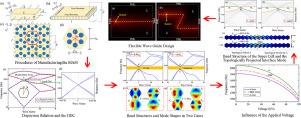当前位置:
X-MOL 学术
›
J. Sound Vib.
›
论文详情
Our official English website, www.x-mol.net, welcomes your
feedback! (Note: you will need to create a separate account there.)
Tunable Frequency Response of Topologically Protected Interface Modes for Membrane-type Metamaterials via Voltage Control
Journal of Sound and Vibration ( IF 4.3 ) Pub Date : 2021-03-01 , DOI: 10.1016/j.jsv.2020.115870 Zhenyu Chen , Weijian Zhou , C.W. Lim
Journal of Sound and Vibration ( IF 4.3 ) Pub Date : 2021-03-01 , DOI: 10.1016/j.jsv.2020.115870 Zhenyu Chen , Weijian Zhou , C.W. Lim

|
Abstract The analogy of quantum spin Hall effect in phononic fields has received enormous attentions these years. A significant hallmark of quantum spin Hall effect is that it can support interface modes that are protected by topology and robust to structural disturbance. However, researches on this topic are often limited to the passive structures that manifest topologically protected interface modes at fixed and narrow frequency ranges. In view of the shortage of non-passive topological metamaterial systems, this work has a primary motive to study the active control of quantum spin Hall effect in soft membrane-type metamaterials (MAM). After introducing sandwiched membrane-type acoustic metamaterials, the plane wave expansion method is adopted to analytically capture the system dispersion properties. A finite element model is further developed and a very good convergence with analytical result is presented. Further, by adjusting locations of spraying discs in the honeycomb lattice without violating the C 6 v symmetry, topological phase inversion is observed around a double Dirac cone at the center of the Brillouin zone, separating the topologically trivial state from the nontrivial counterpart. The topologically protected interface modes (TPIMs) around the interface between metamaterials of trivial and nontrivial states are observed. Additionally, to actively control working frequency of the TPIM, an electrical voltage that lies within the locking-up limit is applied to MAM. It is concluded that the topological interface state and the topological bandgaps are very sensitive to the applied voltage, while the system localization behavior is not influenced by the voltage. Utilizing this topologically protected interface state analysis, a straight path and a zig-zag path are designed to control wave propagation in the structure. Conclusively, a voltage-controlled topological metamaterial system is designed to broaden the working frequency range of TPIM.
中文翻译:

膜型超材料拓扑保护界面模式的可调频率响应通过电压控制
摘要 近年来,声子场中量子自旋霍尔效应的类比受到了极大的关注。量子自旋霍尔效应的一个重要标志是它可以支持受拓扑保护且对结构扰动具有鲁棒性的界面模式。然而,关于该主题的研究通常仅限于在固定和窄频率范围内表现出拓扑保护界面模式的无源结构。鉴于非被动拓扑超材料系统的不足,这项工作的主要动机是研究软膜型超材料(MAM)中量子自旋霍尔效应的主动控制。引入夹层膜式声学超材料后,采用平面波展开法对系统色散特性进行解析捕捉。进一步开发了有限元模型,并呈现出与分析结果非常好的收敛性。此外,通过在不违反 C 6 v 对称性的情况下调整蜂窝晶格中喷射盘的位置,在布里渊区中心的双狄拉克锥周围观察到拓扑相反转,将拓扑平凡状态与非平凡对应物分开。观察到平凡和非平凡状态的超材料之间的界面周围的拓扑保护界面模式(TPIM)。此外,为了主动控制 TPIM 的工作频率,将一个处于锁定限制范围内的电压施加到 MAM。结论是拓扑界面态和拓扑带隙对施加的电压非常敏感,而系统定位行为不受电压影响。利用这种拓扑保护的界面态分析,设计了一条直线路径和一条锯齿形路径来控制结构中的波传播。最后,设计了一种电压控制的拓扑超材料系统来拓宽 TPIM 的工作频率范围。
更新日期:2021-03-01
中文翻译:

膜型超材料拓扑保护界面模式的可调频率响应通过电压控制
摘要 近年来,声子场中量子自旋霍尔效应的类比受到了极大的关注。量子自旋霍尔效应的一个重要标志是它可以支持受拓扑保护且对结构扰动具有鲁棒性的界面模式。然而,关于该主题的研究通常仅限于在固定和窄频率范围内表现出拓扑保护界面模式的无源结构。鉴于非被动拓扑超材料系统的不足,这项工作的主要动机是研究软膜型超材料(MAM)中量子自旋霍尔效应的主动控制。引入夹层膜式声学超材料后,采用平面波展开法对系统色散特性进行解析捕捉。进一步开发了有限元模型,并呈现出与分析结果非常好的收敛性。此外,通过在不违反 C 6 v 对称性的情况下调整蜂窝晶格中喷射盘的位置,在布里渊区中心的双狄拉克锥周围观察到拓扑相反转,将拓扑平凡状态与非平凡对应物分开。观察到平凡和非平凡状态的超材料之间的界面周围的拓扑保护界面模式(TPIM)。此外,为了主动控制 TPIM 的工作频率,将一个处于锁定限制范围内的电压施加到 MAM。结论是拓扑界面态和拓扑带隙对施加的电压非常敏感,而系统定位行为不受电压影响。利用这种拓扑保护的界面态分析,设计了一条直线路径和一条锯齿形路径来控制结构中的波传播。最后,设计了一种电压控制的拓扑超材料系统来拓宽 TPIM 的工作频率范围。











































 京公网安备 11010802027423号
京公网安备 11010802027423号